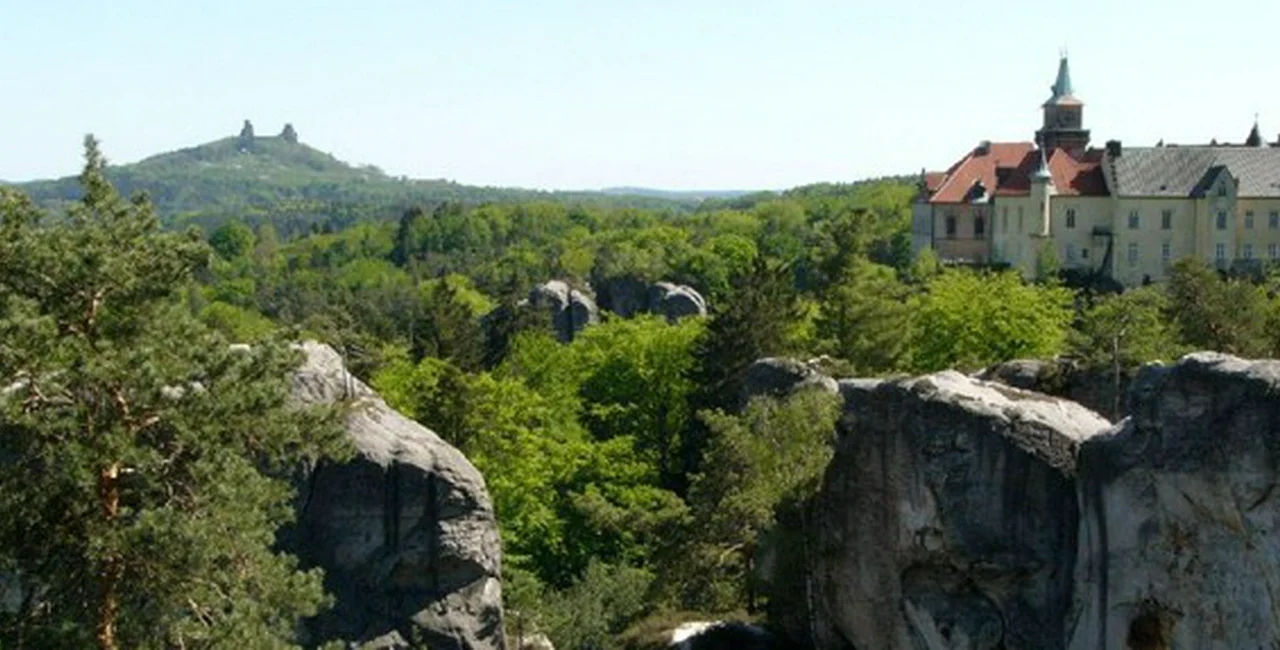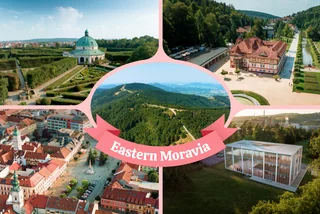Spending Friday to Sunday in the country is a time-honored Czech ritual that has become very popular among those foreigners who´ve made the Czech Republic their home. If you want to pay homage to this tradition there are plenty of places to do so. Český ráj (Bohemian Paradise), approximately 100 kilometers northeast of the capital, is one of the best.
Officially, Český ráj refers to a protected area in the heart of the district, although more generally it ranges from Mnichovo Hradiště in the west to Jičín in the east, with Turnov the “capital” of the area. The unspoiled, unusual landscape, a mixture of undulating terrain and grotesque rock formations, interspersed by small towns, has attracted generations of Czech weekenders.
The most distinctive feature of Český ráj is the rash of sandstone rock cities (skalní města) within its boundaries. These quirky ensembles, clusters of curvy grey sandstone pillars contorted into strange shapes and riven by fissures, are the result of erosion. They pop up like mushrooms in several places in the Czech Republic, and Český ráj, Saxon Switzerland (Český Švýcarsko) and the Adršpach and Teplice Rocks (Teplicko-Adršpaššké skály) are three of the most famous examples.
Rock cities are naturally a magnet for rock climbers, who you´ll see in abundance, as they crawl up the rock surfaces like insects, but there are plenty of opportunities for less extreme activities. Numerous hiking trails twist their way through the rock cities and Český ráj as a whole, and mountain bikers enjoy navigating their way through the unusual backdrop of tapering sandstone columns. On a more sedate level, the rock cities are ideal for gentle strolls, and are thus popular with families; children in particular appreciate the quirky shapes of the stones. In the heat of summer the narrow passages among the cliffs offer a welcome and shady retreat. As well as recreational possibilities, the rocks cities are of great interest to geologists and naturalists.
One of the many pleasures of Český ráj is that unlike the very conspicuous peaks of the České středohoří mountains or the rock cities of Saxon Switzerland, much of the landscapes of Český ráj, are hidden, almost secret. They only reveal themselves at the last minute, as you approach them; heightening the sense of surprise.|

Valdštejn and Hrubá Skála
Hrubá skála (see the top image) is one such secret, and perhaps the finest of the rock cities of Český ráj: it has a full complement of fantastic (in the original sense of the word) rock shapes to admire, endless trails to explore and excellent vyhlídky or view points. Playful names names such as the Cigar (Doutník), Sfinga (Sphinx), and Baton (Taktovka), give an idea of some of the strange shapes found here. At the heart of this part of Český ráj is Hrubá Skala château, a 19th century baronial reconstruction, with a hotel, restaurant and excellent views over the whole area, including Trosky (see below). Close by is Valdštejn, once a Gothic fortress but not much left save a chapel, after restoration projects came to nothing. Despite the lack of things to see, it‘s an atmospheric spot, and the Gothic atmosphere is enhanced by a statue-lined bridge leading to Valdštejn. Valdštejn is also an intriguing sight viewed from the train to Jičín – the ruin is perched on a ridge and half-hidden amongst trees and rock formations. Hrubá skala and Valdštejn are within easy reach of Turnov and Trosky, and the Turnov-Jičín railway line passes near; the closest station is Kralovice-Sedmihorky. Jičín is further away but still accessible on foot, or by train.
Prachovské skály
The very name of this stone city describes it: prach is the Czech word for dust, after the gently eroding rock, carpeting the ground and paths that twist tortuously around the giant pillars of sandstone. As in the other stone cities, there are numerous trails to follow. The rocks are northwest of Jičín and within easy reach of the town, and Trosky and Hrubá skála lie to the northwest.
Trosky
The rock city is the natural landmark of Český ráj; Trosky Castle is the manmade landmark. You´ll see it on tourist literature everywhere, and it´s easy to see why. Stumpy twin castles known as Grandmother (Bába) and Virgin (Panna) face each other across across a narrow ridge linking them. Trosky is undeniably impressive, and leaves one wondering how they built it. Getting into the castle is easier than it looks and does not involve gravity-defying efforts. Trosky is located between Jičín and the Prachovské skály. The nearest stations are Borek p.Troskami, Ktová and Rovensko p.Troskami, on the Turnov-Jičín line.

Sobotka and Kost
Sobotka, in the southwest of Český ráj is more isolated and there is little to see here, although the oval-shaped hunting lodge, known as zámek Humprecht, on the northern edge of the town is worth a quick look. The real attraction here is the castle at Kost, three kilometers north of Sobotka, in the village of Podkost. The robust castle, perched on an equally robust outcrop that looks like a very overweight version of a rock city column, preserves its medieval features. A sparse bus service runs to Podkost from Sobotka, but the distance is walkable.
Jičín
If you spend any time in Český ráj you´ll probably find yourself passing through Jičín, a pleasant place to stop off and a good base for exploring the area. The little town is notable for its connection with the omnipresent historical figure Albrecht von Waldstein (Valdštejn in Czech), who owned the château that bears his name, in Jičín. The structure dominates the town square and was where Austria, Russia and Prussia formed the Holy Alliance against Napoleon in 1813. Today it houses a museum and gallery. At the other end of the (fictional) local character scale, Jičín is also associated with Rumcajs, the little bearded children´s story character who you´ll probably encounter at some point on a visit to Český ráj.
Getting there
Jičín, Sobotka and Turnov and are accessible by bus from Prague, usually from the Černy Most bus station, beside the metro terminus. Bus is the quickest mode of transport although journeys often involve changing. Reaching them by train is more scenic but slower, as there are no direct routes. The Jičín to Turnov line is handy for stopping off at Hrubá skála/Valdštejn, Trosky and Turnov.
Bear in mind that public transport services are less frequent at weekends and even less so in rural areas, so if you are considering a day trip, don´t assume you can just hop on a bus or train in the early evening. A little planning is necessary to avoid being stranded in the middle of the weekend. You can feed in all your destination details at www.idos.cz to get a good idea of travel possibilities.
Another good idea is to buy the map of Český ráj (No. 19), produced by the Klub Českých Turistů and part of a series of maps that covers the whole country. It shows trails marked in red, yellow, blue and green. For cyclists, the Shocart active map No. 12 covers Český ráj.
Read more Travel/Tourism articles.












 Reading time: 6 minutes
Reading time: 6 minutes 






















